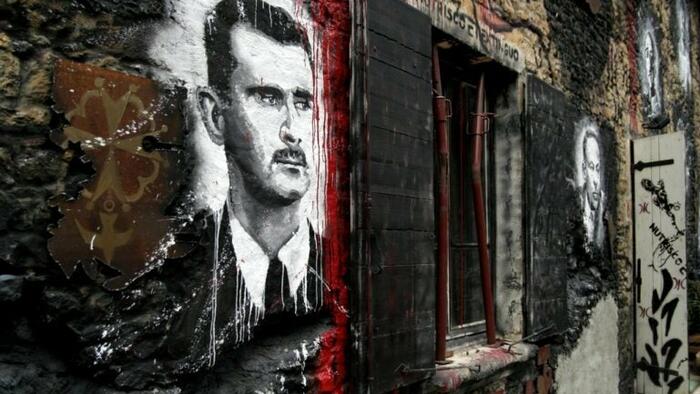The geopolitical landscape in the Middle East has shifted dramatically with the fall of Damascus, marking a watershed moment in the Syrian conflict and signaling the potential end of over five decades of leadership by the Assad family. Unverified reports suggest that President Bashar al-Assad and key officials may have either fled to Dubai or nearby coastal areas like Latakia, a strategic city in their factional stronghold. Eyewitness accounts highlight a panicked retreat of Syrian military and security forces, who reportedly abandoned their posts in the capital, leaving strategic sites vulnerable to opposition control. As the armed jihadists, purportedly backed by Turkey, advanced, they have successfully entered the heart of the capital, showcasing a rapid transition of power without substantial resistance from government forces.
Multiple sources, including Al Jazeera, present video evidence of Syrian soldiers in Damascus withdrawing from their positions. Footage shows armed personnel changing out of military uniforms into civilian clothes, indicating a complete breakdown of order and morale within Assad’s troops. This exodus underscores a significant turning point in the ongoing conflict, leading to the abandonment of critical military infrastructure—the Defence Ministry headquarters has reportedly come under rebel control, further solidifying the transition away from a once-thriving state apparatus. Instead of a forceful standoff, the sheer pace of the insurgent advance highlights a systematic collapse of government power, contradicting earlier narratives of a steadfast military presence.
The situation escalated into a near-total evacuation of key national institutions, including Damascus International Airport, which appears deserted of personnel. Abandoned military equipment litter the streets, signaling the rapid crumbling of governmental authority. Reports also indicate that Iranian military advisors have evacuated, further exemplifying the disintegration of Assad’s support network. The lack of organized defense from the Syrian Army raises questions about the military’s ability to sustain prolonged warfare against opposition factions, suggesting a calculated decision rather than merely an unmanly retreat. The rapid movement of insurgents towards pivotal cities like Homs and suburbs of Damascus demonstrates how quickly the tide has turned against the Assad regime, highlighting the volatility of the situation.
Amidst the chaos, unverified claims of a plane carrying Assad crashing have circulated, adding to the confusion around his whereabouts and political future. Despite these turbulent reports, state media refuted initial claims of his departure, insisting that he remains within the capital. The internal contradictions paint a picture of desperation and a façade of normalcy being upheld by government officials as they seek to quell paranoia and maintain semblances of authority. Meanwhile, many prominent families are reportedly fleeing towards Lebanon, highlighting the growing fear driven by opposition forces gaining ground. This flight signals an uncertain future for many communities, as a shifting power landscape emerges within and around Damascus.
As the rebel forces advance, the expectations of a drawn-out conflict have diminished. Instead, the possibility of a negotiated transition appears more viable as both domestic and international stakeholders engage in discussions about Syria’s future. Reports of a potential power-sharing arrangement or an exit strategy for Assad suggest pragmatism over continued violence. However, consistent claims of ongoing military resistance point to a deep-rooted conflict that is far from over, especially given the presence of diverse factions vying for influence in the power vacuum left by Assad’s retreating forces. The Syrian Observatory for Human Rights has indicated that key neighborhoods could soon be fully encircled by insurgents, further isolating the government.
Continuing unrest has led to widespread protests, challenging Assad’s narrative of maintaining control. Demonstrations prominently feature the symbolic destruction of statues honoring Hafez Assad, Bashar’s father, representing a clear rejection of the tyrannical rule that has shaped Syrian politics since 1970. The potential establishment of extremist rule under groups like Hayat Tahrir al-Sham remains a key concern for many Syrians, especially minority communities who have historically faced persecution. Observers and regional analysts warn that the collapse of Assad’s regime could incite deeper ethnic and sectarian rifts, complicating an already dire humanitarian landscape and positioning neighboring countries on high alert.
In conclusion, the unexpected fall of Damascus signals not only the rapid decline of the Assad regime but also a critical juncture for the future of Syria as a whole. The fabric of what was once a unified state under Baathist rule is unravelling, presenting both challenges and opportunities for diverse factions vying for control. The intricate interplay of local and regional politics, coupled with the collective aspirations of the Syrian populace for a new beginning, presents a complex and uncertain path forward. As the dust begins to settle in a changing capital, any transition will likely reshape the geopolitical balance in the Middle East and determine the evolution of governance in Syria for generations to come.

